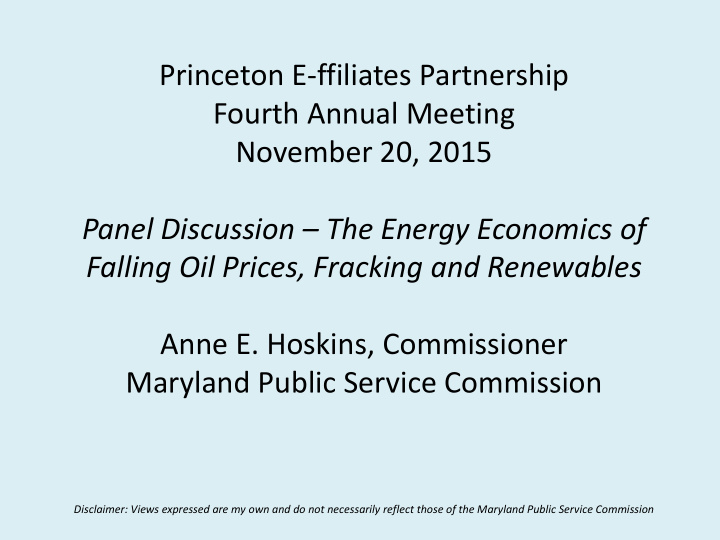



Princeton E-ffiliates Partnership Fourth Annual Meeting November 20, 2015 Panel Discussion – The Energy Economics of Falling Oil Prices, Fracking and Renewables Anne E. Hoskins, Commissioner Maryland Public Service Commission Disclaimer: Views expressed are my own and do not necessarily reflect those of the Maryland Public Service Commission
Historical Context: The 1970s • High oil prices in the 1970s incentivized “Washington and a bevy of states [to throw] taxpayer subsidies at then- wacky ideas like wind and solar power.” The New Republic, 2014 Elkton, Maryland, 1973 President Carter at the White https://cecilcounty.wordpress.com/2012/04/08/as-gas-prices-hit-all-time-high-in-cecil-county-the-1970s-energy-crisis-recalled/ House, 1979 http://io9.com/the-sad-fate-of-jimmy-carters-solar-panels-1469104906
Historical Context: The 1980s and 1990s “Historically, lower fossil fuel prices have impacted renewable • energy resources like kryptonite . . . in the 1980s and 1990s, when nascent solar, wind and geothermal markets in California keeled over as North America suddenly became awash in cheap oil and natural gas.” The Guardian, 2014 Natural Gas Plant 1991 Ford Explorer http://www.cargurus.com/Cars/1991-Ford-Explorer-Pictures-c288#pictureId:9410531 https://photos.prnewswire.com/prnvar/20150629/226652
Natural Gas Prices and their Impact on Regulation
As Gas Prices Decline… – Increasing Energy Efficiency goals: 2% of gross energy sales from 2013 baseline – Increasing investments in Transmission and Distribution Systems – Increasing Renewable Portfolio Standards: • Mixed impacts on competitive generation markets (natural gas vs. nuclear vs. coal). Regulators need to ensure security of supply for reliability.
If gas (and electricity) prices go up . . . • Customer rates could increase significantly due to continued T&D network investment cost recovery and increasing commodity prices. - Will existing safety net programs be sufficient to ensure access to essential electricity and gas services by lower income customers or will new rate-making methods be necessary? - Will the increased rates drive customers off the grid and if so, how will the long term T&D maintenance costs be recovered? • Increased demand for renewables and other DG, including customer-generated energy like solar PV, Combined Heat & Power and Energy Efficiency. • Potentially mixed impacts on State carbon reduction objectives (gas vs. coal; and gas as a bridge fuel).
Impact on Maryland’s Greenhouse Gas Goals http://climatechange.maryland.gov/plan/ The Maryland Climate Change Commission recently proposed extending the State’s Greenhouse Gas goal – from 25% reduction by 2020 to a 40% reduction by 2030 (2006 baseline)
The Interplay between Renewables, Gas and Storage: The “Duck Curve” http://www.fortnightly.com/fortnightly/2013/12/tranche-warfare In CA the ramp-up in the evening hours – when solar PV fades but load is still high – is a key driver of capacity needs, which is currently being met by natural gas generation facilities. But if battery storage can fill that gap . . .
Renewables + Storage = less natural gas? • High hopes for energy storage paired with renewables – especially solar PV – where renewable penetration is high (Hawaii or California) • Battery storage pilots underway in several states, e.g. Hawaii, California, New York, Oregon
Recommend
More recommend